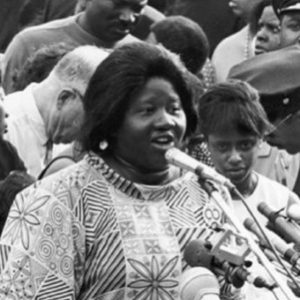
Johnnie Tillmon
The wage discrimination women faced led many to rely on funding from the government to survive. Johnnie Tillmon’s “Welfare is a Women’s Issue”, published in Liberation News Service in 1972, examines the unfair treatment women on welfare faced, and called for a restructuring of the entire welfare system of the 1960s. Tillman begins the essay bluntly stating, “I’m a woman. I’m a black woman. I’m a poor woman. I’m a fat woman. I’m a middle-aged woman. And I’m on welfare” (106). Her choppy lines demand that the reader attend to each component of her description. She goes on to explain that if you qualify as any of those previous statements, “you count less as a human being,” and if you are all of them, “you don’t count at all. Except as a statistic” (106). As a 45-year-old mother of six who is on welfare, Tillmon has seen the inequity women face first hand, especially those in the working class. Tillmon paints a moving image of the direct discrimination women face, and how they are actively pushed into this position. She explains that “44% of all families are headed by women” (107), meaning there is no man in the picture. In this case “a woman with just three kids,” who is “earning the full federal minimum wage of $2.00 an hour, is still stuck in poverty” (108). And that only if this woman is paid the full minimum wage, which is unlikely. As Tillmon writes, “There are some ten million jobs that now pay less than the minimum wage, and if you’re a woman, you’ve got the best chance of getting one” (108). Working class women had no way of supporting themselves, or their families. The oppression they faced was insurmountable, made worse by the vicious stereotypes (their laziness, for instance) to which they were subjected.
Tillmon’s document challenges the unfair policies of the Aid to Families with Dependent Children (A.F.D.C), an organization that decided welfare aid at this time. As she discusses the unfairness of the A.F.D.C’s current system, she describes a welfare woman’s relationship with the A.F.D.C as a “supersexist marriage” where “you trade a man for the man” (107). In this example “the man” is the current welfare system in place that controls exactly how much money women receive. Tillmon discusses the rule that no family with an “able-bodied” man in the home is allowed to qualify. Thus, if a family is poor and needs welfare, the man must leave the house. The family must disband in order to get enough money from the government to survive, perpetuating inequality and stereotypes against the working class. The wage discrimination women face already strips them of the ability to support themselves and a family. As Tillmon argues, “The problem is that our country’s economic policies deny dignity and satisfaction of self-sufficiency” to “the millions who suffer every day in underpaid dirty jobs—and still don’t have enough to survive” (108). No matter what she does as a black woman who is poor, Tillmon will never be self-sufficient because of the intersectional oppression she faces as a black working class woman.
Tillmon’s organization was the National Welfare Rights Organization (N.W.R.O). It was founded by George Wiley in 1966, and Tillmon was appointed as the leader in 1972. This group “put together [their] own welfare plan, called Guaranteed Adequate Income (G.A.I), which would eliminate sexism from welfare” (109). In this new plan there would be no discrimination or categorization of any kind: “you’d get paid according to need and family size only,” and it would pay attention to the department of labor’s estimates on what sufficient costs of living would be. Overall, Tillmon’s fight for women’s welfare fit more than perfectly into the feminist movement, and empowered working women to fight for what they deserved.
Tillmon, Johnnie. “Welfare is a Women’s Issue.” Rpt. in The American Women’s Movement, 1945-2000: A Brief History with Documents, edited by Nancy Maclean. Bedford/St. Martin’s, 2009. Print.
